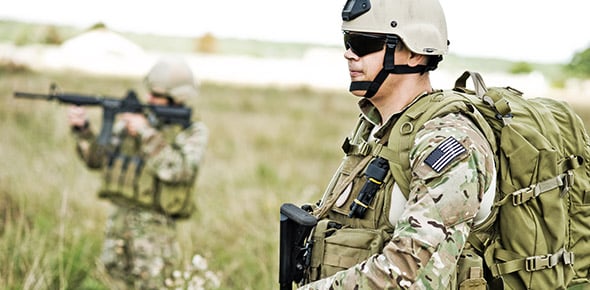43. (017) What is the effect on the redeployment if the collection of...
73. (022) FAACs receive training
4. (003) When performing such duties as reviewing and maintaining a...
38. (016) Who is responsible for accounting for personnel when they...
82. (024) Which steps are accomplished during the first quarter of the...
39. (016) UTCs are aggregated at
54. (019) Logistics planners assigned as the WRMNCO spend most of...
2. (001) If the 7-level logistics craftsman assigns work to personnel...
3. (002) If a 3 skill level logistics planner has been task certified...
45. (018) How are WRM assets identified?
7. (003) What is the most common method for disseminating classified...
33. (013) How do inconsistencies in similar UTCs impact combat...
35. (015) During the task of determining worst case scenario, when do...
64. (021) What happens if the storing unit does not provide the...
26. (013) New UTCs are requested
27. (013) What happens when new equipment types enter the inventory?
32. (013) Accurate management and reporting of UTCs require
55. (019) Which of the following is an example of an unauthorized WRM...
62. (021) Who ensures that WRM authorizations are loaded in the SBSS...
40. (017) In comparison to a deployment, redeployment is not
76. (023) Transfers under ACSA authorities reduce the US “logistics...
85. (025) When part I of the IGESP is unclassified, then it is marked
17. (008) Under the JSPS, the CJCS is also responsible for
36. (016) The RSO&I function is used in deployment as well as
42. (017) How does the redeployment differ from the deployment?
52. (019) Who accompanies the WRMNCO during a surveillance visit?
79. (023) ACSA activities reports are produced
83. (025) What action is required if there are significant changes to...
28. (013) Right-sized UTCs provide greater mission capability to...
48. (018) What must happen before WRM can be used for indirect mission...
69. (022) What office does manpower coordinate with to determine cost...
87. (025) When updated planning data is received the IGESPC
13. (007) If part 1 of volume 2 of the War and Mobilization Plan...
1. (001) What is likely to occur if the logistics planner understands...
29. (013) How should UTCs be developed?
37. (016) Who directs the subordinate commands carry out missions...
65. (022) Who provides the support requests to the FAACs?
71. (022) If the receiver terminates the support agreement what must...
44. (017) What happens if there is limited MHE available for...
56. (019) Who is responsible for reconstituting WRM that is coded for...
81. (024) When creating data in the BaS&E Planning Tool, which of...
86. (025) What is the key to successful expeditionary site planning?
10. (006) A JSCP tasking to develop humanitarian assistance, disaster...
63. (021) What happens before the storing unit provides the outload...
53. (019) Initiating, accomplishing, and directing actions necessary...
18. (008) The CJCS establishes the force apportionment construct in...
21. (010) What product is derived from the process of identifying...
46. (018) What is used to identify like assets according to how they...
50. (019) Who participates in WRM surveillance visits with the CWRMM?
58. (020) In what step of interpreting the WCDO does the WRMO/NCO...
59. (020) In what step of interpreting the WCDO are the WCDO...
70. (022) When the funding annex shows a significant increase
77. (023) What is the difference between an ACSA and the...
25. (013) What LOGMOD level of detail provides the total number of...
51. (019) What type of WRM training is accomplished through a formal...
22. (010) What is the basis for one or more FSA, resulting ICD, or...
66. (022) Where does the FMO get the information it needs to put...
14. (008) The National Security Act of 1947 merged the Department of...
49. (019) What is the relationship between the CWRMO/NCO and the...
72. (022) What is the key to a successful support agreement program?
80. (024) In order for an AOR manager to designate a functional data...
89. (025) Which of the following events take place after the NAF staff...
90. (026) How does the ESSP impact on site survey teams?
20. (009) When the DOD made strategic force management decisions using...
23. (011) In which phase of CAP does the CCDR prepare and submit an...
5. (003) Regional CCDR positions were created to
47. (018) How many WRM use categories are there?
61. (020) What step in interpreting the TPFDD includes identification...
84. (025) When updated planning documents are released, what is the...
12. (006) What action does the Services take when the appropriate DOD...
30. (013) The pilot unit develops manpower details
67. (022) What does the FMO use the cost basis and the cost method...
6. (003) When a joint task force is created during a contingency or...
9. (005) In what step of the contingency planning process does the...
15. (008) The framework for establishing national strategy and making...
68. (022) Who works with the manpower office to determine manpower...
11. (006) CCDRs develop FUNCPLANs in response to CJCS requirements and...
24. (012) What type of order is issued when the NCA decides to begin...
34. (014) What is the role of MAJCOMs and AFCCs in the deployment...
74. (023) Which of the following is not a MAJCOM ACSA manager...
75. (023) What relationship does the MAJCOM’s FM have with the DFAS?
78. (023) Generally speaking, a deployed LRS’s responsibility for...
8. (004) When the CCDR issues a detailed letter of instruction with...
60. (020) At what step of interpreting the VAL is a meeting held to...
88. (025) Which of the following actions occurs before the IGESPC...
19. (008) One of the functions of the PPBES is
57. (020) In interpreting the WPARR, what occurs after the WRMO/NCO...
41. (017) What is the relationship between the redeployment process...
16. (008) If the JSPS enables the CJCS to carry out responsibilities...
31. (013) What happens if a non-pilot unit does not provide the...
















